

Joel Simon. Evolving Floor Plans is an experimental research project exploring speculative, optimized floor plan layouts.
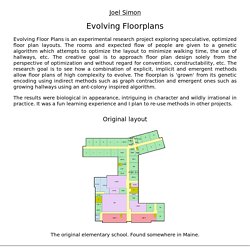
The rooms and expected flow of people are given to a genetic algorithm which attempts to optimize the layout to minimize walking time, the use of hallways, etc. The creative goal is to approach floor plan design solely from the perspective of optimization and without regard for convention, constructability, etc. The research goal is to see how a combination of explicit, implicit and emergent methods allow floor plans of high complexity to evolve. The floorplan is 'grown' from its genetic encoding using indirect methods such as graph contraction and emergent ones such as growing hallways using an ant-colony inspired algorithm.
The results were biological in appearance, intriguing in character and wildly irrational in practice. Original layout The original elementary school. 'Optimized' Left: Optimized for minimizing traffic flow bewteen classes and material usage. Windows. Replika. A Neural Conversational Model Google. Robo Brain. Noam Chomsky on Where Artificial Intelligence Went Wrong. An extended conversation with the legendary linguist Graham Gordon Ramsay If one were to rank a list of civilization's greatest and most elusive intellectual challenges, the problem of "decoding" ourselves -- understanding the inner workings of our minds and our brains, and how the architecture of these elements is encoded in our genome -- would surely be at the top.
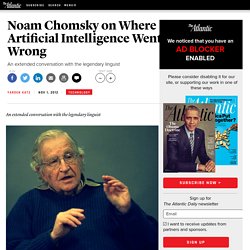
Yet the diverse fields that took on this challenge, from philosophy and psychology to computer science and neuroscience, have been fraught with disagreement about the right approach. In 1956, the computer scientist John McCarthy coined the term "Artificial Intelligence" (AI) to describe the study of intelligence by implementing its essential features on a computer. Instantiating an intelligent system using man-made hardware, rather than our own "biological hardware" of cells and tissues, would show ultimate understanding, and have obvious practical applications in the creation of intelligent devices or even robots. Inteligencia Artificial: Ramon Llull y el Ars Magna. AI designs its own video game - tech - 07 March 2012. Video games designed almost entirely by a computer program herald a new wave of AI creativity Read more: "Better living through video gaming" Have a go at the game designed especially for New Scientist by the AI Angelina: "Space Station Invaders" IT IS never going to compete with the latest iteration of Call of Duty, but then Space Station Invaders is not your typical blockbuster video game.
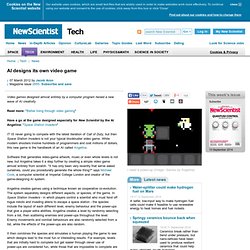
While modern shooters involve hundreds of programmers and cost millions of dollars, this new game is the handiwork of an AI called Angelina. Software that generates video-game artwork, music or even whole levels is not new, but Angelina takes it a step further by creating a simple video game almost entirely from scratch. Angelina creates games using a technique known as cooperative co-evolution.
It then combines the species and simulates a human playing the game to see which designs lead to the most fun or interesting results. Combining these simple elements can produce surprisingly nuanced effects. Home. Humanoid Robot Learns Language Like a Baby. With the help of human instructors, a robot has learned to talk like a human infant, learning the names of simple shapes and colors.
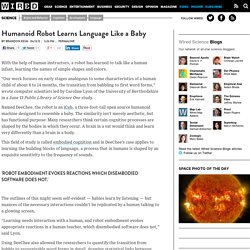
“Our work focuses on early stages analogous to some characteristics of a human child of about 6 to 14 months, the transition from babbling to first word forms,” wrote computer scientists led by Caroline Lyon of the University of Hertfordshire in a June 13 Public Library of Science One study. Named DeeChee, the robot is an iCub, a three-foot-tall open source humanoid machine designed to resemble a baby. The similarity isn’t merely aesthetic, but has functional purpose: Many researchers think certain cognitive processes are shaped by the bodies in which they occur. A brain in a vat would think and learn very differently than a brain in a body. This field of study is called embodied cognition and in DeeChee’s case applies to learning the building blocks of language, a process that in humans is shaped by an exquisite sensitivity to the frequency of sounds.
Are You Chatting With a Human or a Computer? One Per Cent: Bot with boyish personality wins biggest Turing test. Celeste Biever, deputy news editor Eugene Goostman, a chatbot with the personality of a 13-year-old boy, won the biggest Turing test ever staged, on 23 June, the 100th anniversary of the birth of Alan Turing.

Held at Bletchley Park near Milton Keynes, UK, where Turing cracked the Nazi Enigma code during the second world war, the test involved over 150 separate conversations, 30 judges (including myself), 25 hidden humans and five elite, chattering software programs. Google scientists find evidence of machine learning. Google scientists working in the company's secretive X Labs have made great strides in using computers to simulate the human brain.
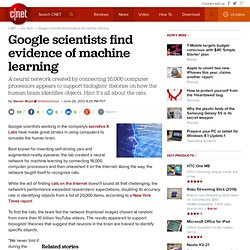
Best known for inventing self-driving cars and augmented-reality eyewear, the lab created a neural network for machine learning by connecting 16,000 computer processors and then unleashed it on the Internet. Along the way, the network taught itself to recognize cats. Using large-scale brain simulations for machine learning and A.I. You probably use machine learning technology dozens of times a day without knowing it—it’s a way of training computers on real-world data, and it enables high-quality speech recognition, practical computer vision, email spam blocking and even self-driving cars.

But it’s far from perfect—you’ve probably chuckled at poorly transcribed text, a bad translation or a misidentified image. We believe machine learning could be far more accurate, and that smarter computers could make everyday tasks much easier. So our research team has been working on some new approaches to large-scale machine learning. What is AI? Part 13. By Jack Copeland © Copyright B.J.
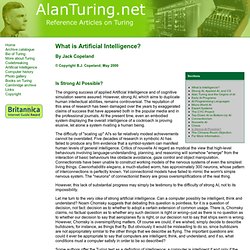
Copeland, May 2000. Virtual robot links body to numbers just like humans - tech - 11 November 2011. Video: See a virtual robot mimic a human baby A virtual robot has acquired a cognitive wrinkle common in people – further evidence that computers need bodies if they're ever going to think like us Read more: "Squishybots: Soft, bendy and smarter than ever.

Do thoughts have a language of their own? - opinion - 08 December 2011. Read full article Continue reading page |1|2 What is the relationship between language and thought?

The quest to create artificial intelligence may have come up with some unexpected answers. Tech in a Minute: Can machines ever be intelligent? Sandrine Ceurstemont, editor, New Scientist TV Machines may be capable of impressive feats, but can they ever be truly intelligent? In this animation produced by The Open University, we follow a famous thought experiment proposed by philosopher John Searle that challenges the notion of strong AI - that a machine can ever successfully perform an intellectual task as well as a human. Today, people use computers to improve their own intelligence and communication skills, putting into question the relationship between language and thought. I, Robopsychologist, Part 1: Why Robots Need Psychologists. Andrea Kuszewski is a behavior therapist and consultant, science writer, and robopsychologist at Syntience in San Francisco.
She is interested in creativity, intelligence, and learning, in both humans and machines. Find her on Twitter a @AndreaKuszewski. “My brain is not like a computer.” I, Robopsychologist, Part 2: Where Human Brains Far Surpass Computers. Andrea Kuszewski is a behavior therapist and consultant, science writer, and robopsychologist at Syntience in San Francisco. She is interested in creativity, intelligence, and learning, in both humans and machines. Find her on Twitter at @AndreaKuszewski. A computer chip that emulates the human brain - and might one day replace it. The Little Thoughts of Thinking Machines. Next: About this document John McCarthy Computer Science Department Stanford University Stanford, CA 94305 jmc@cs.stanford.edu When we interact with computers and other machines, we often use language ordinarily used for talking about people.
We may say of a vending machine, `It wants another ten cents for a lousy candy bar.' A conversation between Siri and a Furby is like listening to HAL 9000 break wind. One word: batteries. —this space intentionally left blank I was ten, and I either didn't think about that or they made the battery case impossible to find. I seem to recall it being the latter, as I'm sure it occurred to me to just take the damn batteries out. Also, I feel the need to rationalize the fact that I had a Furby when I was ten— my little sister wanted one for Christmas that year, and my parents subscribed to the school of "if one kid gets it, the other has to get it too or they'll bitch about it forever.
" How the Cleverbot Computer Chats Like a Human. Terry Winograd. Murió John McCarthy, pionero que acuñó el término “inteligencia artificial” Inteligencia Artificial: 5 inquietantes robots de aspecto humano. Inteligencia Artificial: Kilobots, un ejército de robots programables. Inteligencia Artificial: Arquitectura automática. MIT diseña un chip que funciona como las neuronas cerebrales. Inteligencia Artificial: John von Neumann y el nacimiento de la vida artificial. Inteligencia Artificial: 10 lecturas imprescindibles. Inteligencia Artificial: 10 sorprendentes avances de 2011.
La Inteligencia Artificial, dijo John McCarthy cuando acuñó el término en las conferencias de Darmouth de 1956, es: "...la ciencia e ingeniería de hacer máquinas inteligentes, especialmente programas de cómputo inteligentes. " Ese sentido no ha cambiado desde entonces. En cambio, las técnicas y aplicaciones de la Inteligencia Artificial son cada más variadas, profundas y sorprendentes. A pasos exponenciales inundarán nuestras vidas y pronto serán tan omnipresentes que apenas las percibiremos, como hoy con sucede con la televisión y el Internet. En este artículo presento un recopilación de algunos de los muchos avances ocurridos durante 2011. 1 Supercomputadora Watson La construyó IBM luego de años de investigación en los que confluyeron muchas áreas de la ciencias de la computación. 2 Futuros comentaristas deportivos El sistema creado por investigadores de la Ecole Polytechnique Federale de Lausanne en Suiza ya sabe identificar y rastrear jugadores de baloncesto.
Inteligencia Artificial: Eliza y las conversaciones con una máquina. Inteligencia Artificial: un futuro marcado por la interpretación de imágenes. Developing artificial intelligence systems that can interpret images. Will You Live Forever—or until Your Next Software Release—by Uploading Your Brain into a Computer? Siri en terapia con ELIZA. From Eliza to A.L.I.C.E. (A.L.I.C.E. AI Foundation)